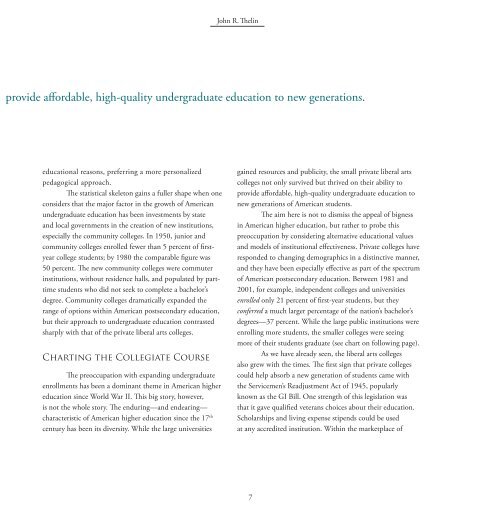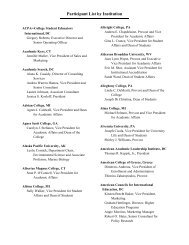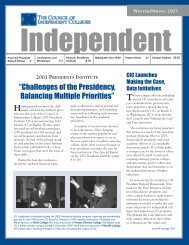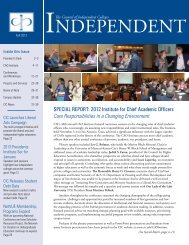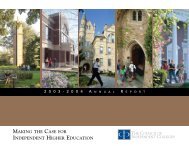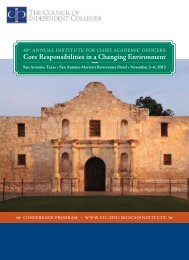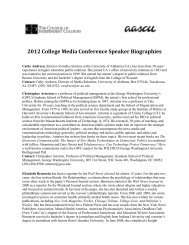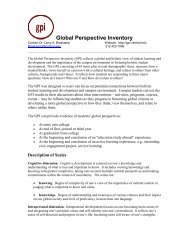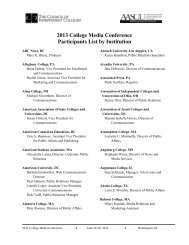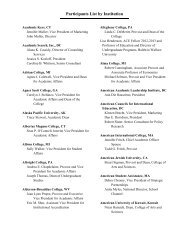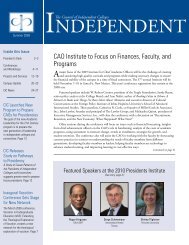Meeting the Challenge: - The Council of Independent Colleges
Meeting the Challenge: - The Council of Independent Colleges
Meeting the Challenge: - The Council of Independent Colleges
You also want an ePaper? Increase the reach of your titles
YUMPU automatically turns print PDFs into web optimized ePapers that Google loves.
John R. <strong>The</strong>lin<br />
provide affordable, high-quality undergraduate education to new generations.<br />
educational reasons, preferring a more personalized<br />
pedagogical approach.<br />
<strong>The</strong> statistical skeleton gains a fuller shape when one<br />
considers that <strong>the</strong> major factor in <strong>the</strong> growth <strong>of</strong> American<br />
undergraduate education has been investments by state<br />
and local governments in <strong>the</strong> creation <strong>of</strong> new institutions,<br />
especially <strong>the</strong> community colleges. In 1950, junior and<br />
community colleges enrolled fewer than 5 percent <strong>of</strong> firstyear<br />
college students; by 1980 <strong>the</strong> comparable figure was<br />
50 percent. <strong>The</strong> new community colleges were commuter<br />
institutions, without residence halls, and populated by parttime<br />
students who did not seek to complete a bachelor’s<br />
degree. Community colleges dramatically expanded <strong>the</strong><br />
range <strong>of</strong> options within American postsecondary education,<br />
but <strong>the</strong>ir approach to undergraduate education contrasted<br />
sharply with that <strong>of</strong> <strong>the</strong> private liberal arts colleges.<br />
Charting <strong>the</strong> Collegiate Course<br />
<strong>The</strong> preoccupation with expanding undergraduate<br />
enrollments has been a dominant <strong>the</strong>me in American higher<br />
education since World War II. This big story, however,<br />
is not <strong>the</strong> whole story. <strong>The</strong> enduring—and endearing—<br />
characteristic <strong>of</strong> American higher education since <strong>the</strong> 17 th<br />
century has been its diversity. While <strong>the</strong> large universities<br />
gained resources and publicity, <strong>the</strong> small private liberal arts<br />
colleges not only survived but thrived on <strong>the</strong>ir ability to<br />
provide affordable, high-quality undergraduate education to<br />
new generations <strong>of</strong> American students.<br />
<strong>The</strong> aim here is not to dismiss <strong>the</strong> appeal <strong>of</strong> bigness<br />
in American higher education, but ra<strong>the</strong>r to probe this<br />
preoccupation by considering alternative educational values<br />
and models <strong>of</strong> institutional effectiveness. Private colleges have<br />
responded to changing demographics in a distinctive manner,<br />
and <strong>the</strong>y have been especially effective as part <strong>of</strong> <strong>the</strong> spectrum<br />
<strong>of</strong> American postsecondary education. Between 1981 and<br />
2001, for example, independent colleges and universities<br />
enrolled only 21 percent <strong>of</strong> first-year students, but <strong>the</strong>y<br />
conferred a much larger percentage <strong>of</strong> <strong>the</strong> nation’s bachelor’s<br />
degrees—37 percent. While <strong>the</strong> large public institutions were<br />
enrolling more students, <strong>the</strong> smaller colleges were seeing<br />
more <strong>of</strong> <strong>the</strong>ir students graduate (see chart on following page).<br />
As we have already seen, <strong>the</strong> liberal arts colleges<br />
also grew with <strong>the</strong> times. <strong>The</strong> first sign that private colleges<br />
could help absorb a new generation <strong>of</strong> students came with<br />
<strong>the</strong> Servicemen’s Readjustment Act <strong>of</strong> 1945, popularly<br />
known as <strong>the</strong> GI Bill. One strength <strong>of</strong> this legislation was<br />
that it gave qualified veterans choices about <strong>the</strong>ir education.<br />
Scholarships and living expense stipends could be used<br />
at any accredited institution. Within <strong>the</strong> marketplace <strong>of</strong><br />
7


